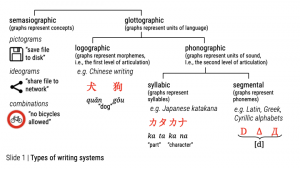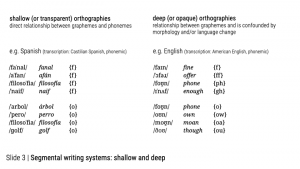Today’s in-class exercise
Week 4
Quicklinks:
Webex Room: weekly live seminars Mo. 16:00–18:00
Schedule: weekly readings, videos and homework
Course Bibliography
Next Videos:
Phonology I
Phonology II
Phonology III
Updates
Last week’s homework is updated with solutions. This week’s homework is uploaded (do before graded test for best results). Check out the further reading.
If you are interested in different dialects of English or other languages, browse through Wikitongues. They have an ever growing repository of samples from authentic speakers. Most big English varieties are in there and some very obscure ones, too.
Bonus material
Tones and tone languages: Height length and roundedness aren’t the only features that a language can rely on. Some languages also use tone. Curious? Watch this.
Wait, you might say, what about intonation in English? Intonation doesn’t exist on the same segmental, phonological level. Tone languages even have intonation on top of having tones. You might find this video interesting.
Finally, if you’re like me, rather than focusing on the English phonemes, you’ll probably spend more time on the more obscure parts of the IPA chart, and wonder about sounds that do not exist in English or German. Curious about clicks, ejectives, implosives? Here is another NativLang video about those.
Here is my favorite language sample to listen to: The Taa language. Listen, and appreciate how simple our job is of describing English phonemes (they even have tones!). By the way, the channel @ILoveLanguages is another great repository for all sorts of languages and dialects. Just be aware that she is a hobbyist who sometimes reads material herself. Generally great quality, though
I also promised to upload another video during the stream, but I have forgotten what topic that was about. If anyone remembers, let me know. 🙂
Week 4 (25 November): Text, video, & homework
Dear all,
thank you for participating in the live session of our seminar. The presentation can be found, as promised, in the folder suitably called Presentations. In preparation for the next week’s session, please do the following:
- Read the following text: Bieswanger & Becker (2017: 58-73), section 3.2 Phonology.
- Watch the following three videos on Phonology.
- Have a look at the sheet with your new homework tasks. You can also find it on the Blackboard page of this seminar in the Course material/Homework folder.
- If you feel like it, fill out this feedback form.
If you have any questions, feel free to contact me at any time!
Best wishes,
Martin
Material for Week 4
Homework for Session 3_Answer Q1-Q3
Please read Bieswanger & Becker 2010: 58-73
See you all next week !
[17310/17339] Reading, videos and homework for week 4
Dear all,
In preparation for week 4, please
- read Bieswanger & Becker 2017: section 3.3 (pp. 58-73)
- watch the following videos
- and do the homework (PDF in the Dropbox).
If you like, discuss the homework here as well: https://blogs.fu-berlin.de/linguistics/forums/topic/creative-spelling/
Exam scores
Just to clarify: What you see on BB is your score, not a grade. Each question is worth three points, so if you see “3.00”, you’ve submitted a very good answer, if you see “1.00”, you got only one point out of three.
Please allow one or two weeks for evaluation. We’ll try to be faster, but we can’t make any promises.
Resources
Dear all,
I publish some of the resources I find useful.
Here you can find the IPA chart.
Interactive visualisations of vowels and consonants in American English
Visualisations of consonants (from the IPA chart)
Best,
Magdalena
Homework for session 3
[Lecture] Week 1: Writing systems
The first point of this week’s lecture was to impress on you the fact that writing systems are not an inherent “part” of language, as
- languages can have more than one writing system (e.g. Serbian, whose speakers use both the Latin and the Cyrillic alphabets);
- a speech community can shift from one writing system to another very suddenly (e.g. Turkish, which shifted from Arabic to Latin in 1928);
- changes within a writing system can be decreed by law (as in the case of the German spelling reform),
None of these things are possible with the sound system of a language or with other aspects of linguistic structure.
The second point was to provide an overview of writing systems, as shown in the following slide:
The third point was to point out that English has a segmental writing system, but not a very transparent one – as opposed, for example, to Spanish:
The reasons for the intransparent orthography of English are largely historical. There are four main reasons:
- For many words, the spelling became fixed early, so when the sound system of English changed, the spelling no longer corresponded to the pronunciation – for example dream was pronounced [drɛam] in Old English, which is fairly transparent, and while the pronunciation changed to [driːm] (due to general sound changes in English), the spelling did not change with it, thus becoming intransparent.
- For other words, the spelling was adjusted at some point in an attempt to capture the new pronunciation – depending on when this happened, different ways of representing a sound were used, leading to inconsistencies.
- For yet other words, the spelling was adjusted to match what people thought was the original pronunciation (etymologizing spellings). For example, the word salmon was always pronounced without an [l] – Middle English [saːˈmuːn], Modern English [ˈsæmən], as it was borrowed from Norman French samoun. However, because the ultimate Latin root salmō contains an <l>, this was added to the English spelling in an attempt at etymological authenticity.
- Loan words typically retain their spelling wholly or partially when borrowed into English.
The final point of the lecture was to draw awareness to the fact that it may be useful to have an orthography that does not correspond to the pronunciation very closely, as it means that homophones (words that sound the same but mean different things) can be disambiguated in writing (for example, by, bye and buy. In this sense, English spelling has some properties of logographic writing systems.

